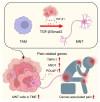Tumor Innervation: From Bystander to Emerging Therapeutic Target for Cancer
- PMID: 41009819
- PMCID: PMC12471000
- DOI: 10.3390/ijms26189257
Tumor Innervation: From Bystander to Emerging Therapeutic Target for Cancer
Abstract
Innervation is ubiquitous in diseased tissues, including cancer. Increasing evidence suggests that innervation not only plays a direct role in cancer pain, but is also closely related to disease progression, including cancer growth, metastasis, and drug resistance. At the molecular level, tumor-associated nerves can interact with cancer cells and the tumor microenvironment through neurotrophic factors, thereby promoting tumor occurrence and development, and represent a potential intervention for solid tumors with nerve enrichment. By dissecting the transcriptome dynamics of cancer-associated neurons with single cell resolution, numbers of novel therapeutic targets for tumor denervation have been uncovered, including a novel phenomenon-Macrophage to Neuron-like cell Transition (MNT). This review systematically summarizes the latest research findings of tumor denervation, from molecular mechanisms to the innovative denervation strategies, paving the way for novel, safe, and effective cancer treatments in the clinic.
Keywords: denervation therapy; tumor innervation; tumor–nerve crosstalk.
Conflict of interest statement
The authors declare that there are no competing interests.
Figures


References
-
- Chang M.T., Bhattarai T.S., Schram A.M., Bielski C.M., Donoghue M.T.A., Jonsson P., Chakravarty D., Phillips S., Kandoth C., Penson A., et al. Accelerating Discovery of Functional Mutant Alleles in Cancer. Cancer Discov. 2018;8:174–183. doi: 10.1158/2159-8290.CD-17-0321. - DOI - PMC - PubMed
Publication types
MeSH terms
Grants and funding
- C4013-24GF, 24102723, 14107624/Research Grants Council of Hong Kong
- PDFS2122-4S06, PDFS2425-4S07/RGC Postdoctoral Fellowship Scheme
- 10210726, 11220576/Health and Medical Research Fund
- ITS/177/22FP, ITS/016/23MS, ITS/301/23/Innovation and Technology Fund
- PFP202210-004/CU Medicine Passion for Perfection Scheme
- 4620528/Faculty Innovation Award 2019
- 8423011/Peter Hung Pain Research Institute Research Fund
- 178896941/CUHK Strategic Seed Funding for Collaborative Research Scheme
- 4054844, 2025.142/Direct Grant for Research
- NL/LT/PDFS2022/0360/22lt, WW/PDFS2023/0640/23en, FPFS/23-24/046/Postdoctoral Fellowship Scheme
LinkOut - more resources
Full Text Sources
Medical

